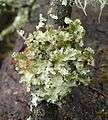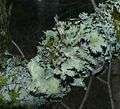Platismatia
Platismatia is genus of medium to large foliose lichens with rather crinkled lobes. The genus is widespread and contains 10 species.[1] They resemble many other genera of foliose lichens in the family Parmeliaceae, particularly Parmotrema, Cetrelia, and Asahinea. Most species are found in forests on the trunks and branches of conifer trees, although some species grow on rocks.[2]
| Platismatia | |
|---|---|
 | |
| Platismatia glauca growing on a Nothofagus tree on Isla Navarino, Chile. | |
| Scientific classification | |
| Kingdom: | |
| Division: | |
| Class: | |
| Suborder: | |
| Family: | |
| Genus: | Platismatia |
| Type species | |
| Platismatia glauca (L.) W.L.Culb. & C.F.Culb. (1968) | |
| Species | |
|
P. commixtum | |
Species of Platismatia can be used to produce an orange-brown, yellow-brown, or brown dye,[3] and at least one species was traditionally used to dye wool in Europe.[4]
Gallery
 Platismatia glauca, Schwäbisch-Fränkische Waldberge, Germany
Platismatia glauca, Schwäbisch-Fränkische Waldberge, Germany Platismatia glauca, Schwäbisch-Fränkische Waldberge, Germany
Platismatia glauca, Schwäbisch-Fränkische Waldberge, Germany Platismatia wheeleri, Underside of thallus; Yelm, Washington, United States
Platismatia wheeleri, Underside of thallus; Yelm, Washington, United States Platismatia tuckermanii, on Spruce branch in Nova Scotia, Canada
Platismatia tuckermanii, on Spruce branch in Nova Scotia, Canada
gollark: What do you mean an "ae rendering program"? You want it to render ae ligatures?
gollark: Not actually sqlite.
gollark: One of the many databases on the osmarks.tk postgres instance.
gollark: No, it runs it through voice recignition and speech synthesis.
gollark: Oh, it would interface with APIONET too.
References
- Kirk PM, Cannon PF, Minter DW, Stalpers JA (2008). Dictionary of the Fungi (10th ed.). Wallingford: CABI. p. 543. ISBN 978-0-85199-826-8.
- Brodo, I. M., S. D. Sharnoff, and S. Sharnoff. 2001. Lichens of North America. Yale University Press: New Haven.
- Brough, S. G. 1984. Dye characteristics of British Columbia forest lichens. Syesis 17: 81-94.
- Uphof, J. C. T. 1959. Dictionary of Economic Plants. Hafner Publishing Co.: New York.
External links
This article is issued from Wikipedia. The text is licensed under Creative Commons - Attribution - Sharealike. Additional terms may apply for the media files.